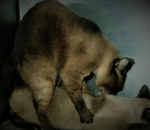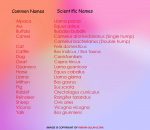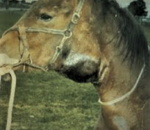Epistaxis in animals is a very uncommon condition. Epistaxis is the spontaneous hemorrhage caused by trauma originating from nostrils. It could be unilateral or bilateral. Bilateral epistaxis may originate either from the nasopharynx or below areas. Epistaxis can also occur as a secondary response to systemic diseases. The volume may be as small flecks mixed with nasal discharge to a large pure blood flow rapidly from nostrils and mouth.
Hemoptysis is the hemorrhage mixed exudate (sanguineous sputum) originating from the lungs.
Etiology of Epistaxis in Animals
Epistaxis is a common condition of horses and cattle. The possible causes are listed below
- Physical trauma: By passing of probang or gastric tube
- Ulcerative tumor
- Trauma to pharyngeal regions and skull
- Dehorning injuries
- Gunshot wounds of respiratory tract
Specific diseases that are involved in epistaxis are following
- Glanders
- Aspergillosis
- Pasteurellosiss
- Equine infectious anemia
- Blue tongue disease
- Bovine Viral Diarrhea
- Malignant catarrhal fever
- Anthrax
- Bacillary hemoglobinuria
- Sheep nasal bots
- Granulomas of fungal origin
Non-specific diseases causing nose bleed are following
- Acute renal failure
- Endocarditis
- Congestive heart failure
- Hepatitis associated clotting defects
- Exercise induced pulmonary hemorrahge
- Purpura hemorrrhagica
- Thrombocytopenia
- Disseminated intravascular coagulpathies
Snakebite, poisoning by certain plants and chemicals may also cause hemorrhage from nostrils.
Clinical Findings of Epistaxis
Passing of perfusing and pureblood from one nostril is usually an indication of the lesion in the nasal cavity.
Hemorrhage originating from the lower respiratory tract is usually bilateral, of foamy texture, and maybe mixed with serous or mucopurulent exudate. Severe hemorrhage may cause circulatory disturbances and even death.

Clotted blood may be seen at the external nostrils, except in the animals having clotting defects.
Treatment of epistaxis in animals
Specific treatment depends upon the nature and location of the cause. Hemorrhages from the guttural pouches need direct ligation of the bleeding vessels. Symptomatic treatment may include
- Complete rest and avoid exercise for animals.
- Cold water immersion or ice packs in and on the nostrils
- Local use of vasoconstrictor drugs e.g. adrenaline as a local spray
- In cases of chronic and repeated episodes of epistaxis, hematinics (Ferrous sulfate or chloride) and vitamin B complex may be used.
- Use of local coagulants, if bleeding spot is located e.g., Alum (10 percent), Tincture ferric per chloride, or Tincture benzoin-co.


